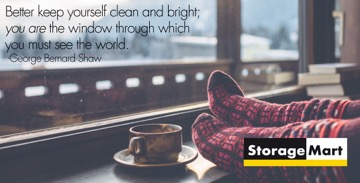Acquiring an excess of ‘stuff’ is an easy thing to do in the materialistic, consumer-driven world we live in. Minimalism may sound like a pretentious design scheme you read about in Scandinavian interior design blogs, but it’s actually an attainable– and desirable– way to approach the space around you. Practicing minimalism simply means using less. In exchange for accumulating dozens of items you only kind of like or might use, you narrow it down to five items you love and always use.
Easily achieved, minimalism can be all about de-cluttering your space. Things are always creeping their way into your life, so keep the doors open to eliminating the excess. You can throw away or donate unwanted items, or put what you don’t have space for in storage.
Here are a few scenarios where minimalism can be applied to reduce the excess and make room for things that matter:
Minimalist office/workspace
When you’re working the most important thing is productivity. A clutter-free workspace is key to this.
The first and most efficient way to minimize the clutter in your workspace is by going paperless. Of course there are times you still need paper, but taking time to review your paper needs could save a lot of space and a lot of trees. Most organizations store all documents digitally, so there is little sense in keeping stacks of paper. There’s no need to print documents or keep paper files when you can store and read them on the computer. If you’re still using a fax machine, stop right now and just use email. It saves time and paper.
Clearing off your desktop is the next obvious step in creating a clean workspace. Only keep things like water bottles, personal photographs, and other essentials on top of your desk, get rid of little trinkets, garbage, stacks of paper, and anything else you can live without. You can also clear unnecessary things like posters and documents off the walls to further remove visual clutter. Finally, reduce your amount of drawer space. A desk with a lot of drawers gives you the opportunity to collect more unimportant junk, so try using a table or a desk with only one drawer instead.
Create space for the new baby
Bringing a new baby into the home is a joyous occasion; however, if you’re in a small space trying to fit in all the new baby products, furniture, toys, and clothes can be a cluttered nightmare. Using hidden storage under beds or sofas is an excellent way to store supplies like diapers, wipes, and clothes in a neat, unnoticeable fashion.
If you have a normal television stand, try exchanging it for a functional dressers with drawers or another type of cabinet. You can easily hold the baby’s clothes, shoes, and toys in the drawers while still keeping the television on top. A foldable changing table is one of the best ways to save space with a new baby. After using it, you can just fold it up and put it away, giving you more room to enjoy time with your little bundle of joy.
In a small space, make everything matter
Living in a small space often becomes cramped and cluttered when the size the space does not match the amount of items you own. A small space can be just as clean and welcoming as a larger space, you just need to only keep what is most important.
Gather everything together and assess what you use, what you need, and what you like. When items do not fall into any of those categories, toss them. There is no point in keeping useless household items or clothing you don’t wear. When you purge your possessions, there will never be a question to what is really important, useful, or of significant sentimental value. Keep your shoes in a closet or on a shelf and always hang up your coats on a hook or hanger. Don’t leave stacks of paper or books lying around, as these will make the space look even smaller and messier.
When you don’t have a lot of room, utilizing vertical space and mirrors is at tried-and-tested method to create more space than there actually is. Using vertical space when hanging shelves or arranging furniture draws the eye upwards, which makes the room feel more spacious. Mirrors do the same by creating reflections and maximizing the space-creating power of light when it bounces around a room.


